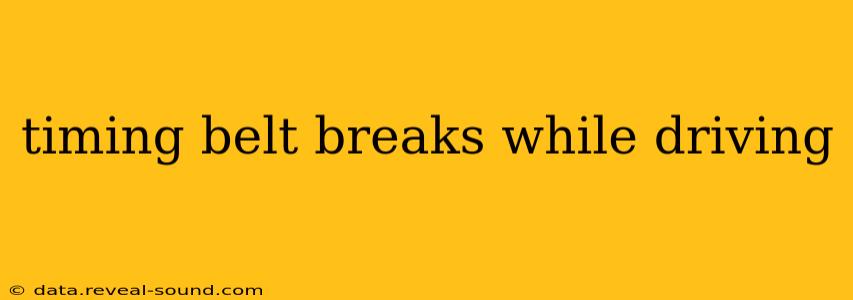A broken timing belt is a serious event that can leave you stranded and potentially cause significant damage to your engine. Understanding what happens when this occurs and how to react is crucial for both your safety and your wallet. This article explores the consequences of a snapped timing belt while driving, explains the potential causes, and offers advice on preventative maintenance.
What Happens When a Timing Belt Breaks While Driving?
The timing belt's primary function is to synchronize the crankshaft and camshaft rotations. When it breaks, this synchronization is lost. The immediate result depends heavily on the engine design and the point of failure. In interference engines (most modern engines), the pistons and valves are designed to operate in incredibly close proximity. A broken belt means the valves and pistons can collide, resulting in:
- Bent Valves: This is the most common and costly consequence. Bent valves require replacement, often necessitating a complete engine rebuild.
- Damaged Pistons: In severe cases, the force of the collision can damage or even crack the pistons.
- Head Gasket Failure: The impact can compromise the head gasket, leading to coolant leaks and potentially further engine damage.
- Engine Seizure: In the worst-case scenario, the engine seizes up completely, rendering the vehicle immobile.
In non-interference engines (older designs), the valves and pistons have enough clearance to avoid a collision, minimizing damage. However, even in these cases, the engine will immediately stop running, leaving you stranded.
Why Does a Timing Belt Break While Driving?
Several factors can contribute to a timing belt snapping:
- Normal Wear and Tear: Timing belts are made of rubber and are susceptible to wear and tear over time. The recommended replacement interval varies depending on the vehicle make and model, but it's typically between 60,000 and 100,000 miles (or 5-10 years). Ignoring this schedule increases the risk of breakage.
- Age and Degradation: Even if the mileage is low, an aged belt can become brittle and prone to cracking, significantly weakening its structural integrity. Exposure to extreme temperatures (both hot and cold) accelerates this degradation.
- Improper Installation: An incorrectly installed timing belt is more likely to fail prematurely. This highlights the importance of professional maintenance and repair.
- Water Damage: Water exposure, especially prolonged immersion, can damage the rubber and cause premature failure.
- Tensioner or Idler Pulley Issues: Problems with the timing belt tensioner or idler pulleys can cause uneven belt wear, increasing the risk of snapping.
What to Do If Your Timing Belt Breaks While Driving?
If your timing belt breaks while driving, the engine will immediately stop. Here's what you should do:
- Safety First: Pull over to the side of the road as safely and quickly as possible, away from traffic. Activate your hazard lights.
- Assess the Situation: Do not attempt to restart the engine. This could cause further damage.
- Call for Assistance: Call a roadside assistance service or a tow truck.
- Wait for Help: Avoid any attempts to repair the belt yourself, as this can be extremely dangerous and may further damage the engine.
How Much Does it Cost to Replace a Broken Timing Belt?
The cost of repairing a broken timing belt varies widely depending on the extent of the damage and the make and model of your vehicle. If only the belt needs replacing, the cost might be relatively modest. However, if the engine suffered internal damage (bent valves, piston damage, etc.), the repair bill can climb dramatically, potentially reaching thousands of dollars. In extreme cases, it might be more economical to replace the entire engine.
What are the signs of a failing timing belt?
A failing timing belt often shows warning signs, though sometimes failure is sudden and unexpected. Look out for:
- Unusual Noises: Squealing, knocking, or clicking sounds from the engine compartment.
- Visible Cracks or Fraying: If you can visually inspect the belt (it's often visible under the engine cover), look for cracks or fraying on the surface.
- Belt slippage: Noticeable changes in engine performance (rough idling, reduced power).
How often should I replace my timing belt?
The recommended replacement interval for a timing belt is usually specified in your vehicle's owner's manual. Generally, it’s in the range of 60,000 to 100,000 miles (or 5 to 10 years), whichever comes first. It's crucial to adhere to this schedule to prevent a potentially catastrophic failure.
This information is for general guidance only. Consult your vehicle's owner's manual and a qualified mechanic for specific advice and maintenance schedules relevant to your car. Ignoring preventative maintenance can result in significant costs and inconvenience.
